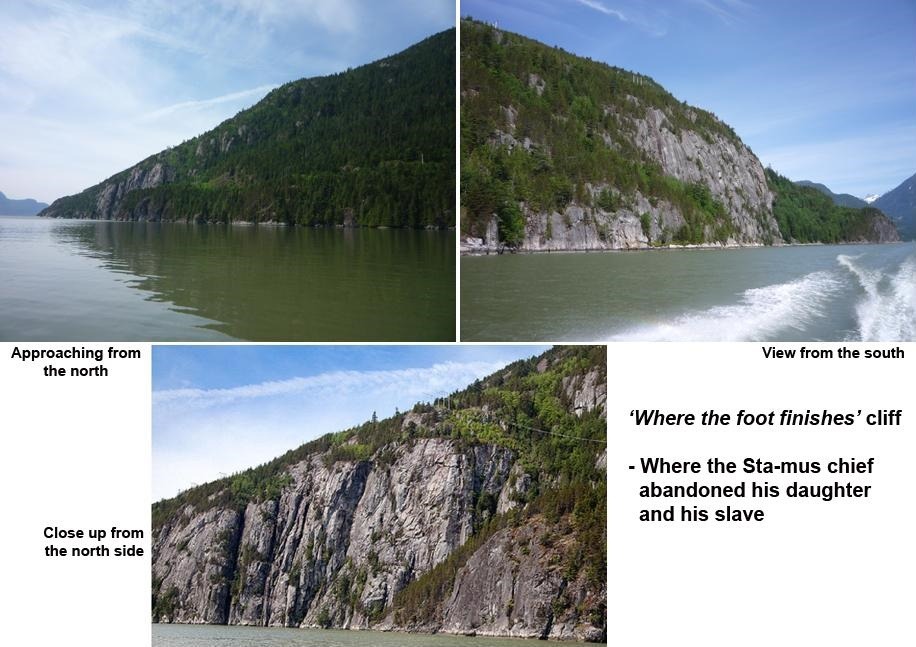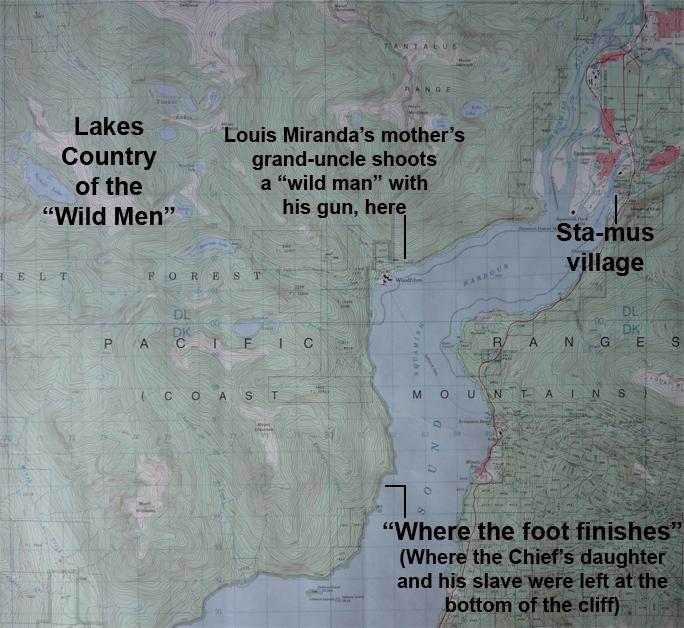Two versions of the Te Smailetl, or Wild People Story
As told by an unnamed informant to Charles Hill-Tout, ca 1897-1900:
Once there was a chief who had an only daughter. He possessed also a male slave. Now this slave was accustomed to sleep at the foot of the daughter’s bed, his bed lying crosswise at the foot of hers. One night he crept to her side and ravished her while she slept. Some little while later she found herself with child, but was wholly ignorant of the person who had brought this shame upon her, not knowing that the slave had lain with her in her sleep.
When she once realizes her condition she is anxious to find out who had visited her, and suspecting that the intruder would pay her another visit some night, she takes some paint and smears it all over the palms of her hands. Shortly after, the slave pays her a second visit. As it is dark she cannot discover who he is, but before he leaves her this time she presses her paint-smeared hands upon his shoulders and leaves thereon an impression of them without his knowledge. In the morning she is greatly surprised to find that it was the slave who had visited her and whom she had painted on the shoulders.
When the chief became conscious of his daughter’s condition he was overwhelmed with shame. And, on learning who it was who had caused this disgrace to fall upon him, he took both the guilty slave and his hapless daughter away in his canoe, and, arriving at a certain lofty cliff which overhung the water, he landed them at its base and left them there to perish together. But, although the cliff was always regarded as inaccessible, in some mysterious way the pair managed to climb it. After they had reached the top they travelled inland amongst the mountains till they came to a lake. Here they stopped and built themselves a house, and here the girl gave birth to her child.
In course of time many other children were born to them, and when these had come to maturity, as there were no others with whom they could mate, they took each other to husband and wife, and in time a large community grew up around the lake. Though living in a wild state, without proper tools or other utensils, they never forgot their mother’s speech, but always conversed together in Squamish. The men were exceedingly tall and very keen of scent and great hunters. They always dressed in garments made from the untanned skins of the animals they had slain. From this habit they were called by the Squamish, smailetl, or wild people.
As told by Louis Miranda to Aert Kuipers, ca 1967-69:
What I am going to tell here was often told to us as a story by our old people. But it was not a story, but something that really happened long ago to the people at Sta-mus.
At Sta-mus there was a highly respected person, and he had only one daughter. He also had a slave. The slave used to lay crosswise at the foot of the girl’s bed when he went to sleep. So it came one night that the slave went after the girl. The slave took the respect of the girl. So it was like that. Then she realized that she was pregnant, but she did not know herself who it was that came to her. She never thought that it could have been her slave.
Then the chief found out that his daughter was pregnant. So he was really overcome with great shame.
But the once-respected girl wanted to know who it could be that was coming to her. So she put some [?]sput-knin[?]* – Indian paint – on her hands, so if he should come again, the person who was coming to her, then she would put her arms around him. Then his back would be marked.
So the next day she saw that it was the slave that had the marked back.
When the father found out that it was the slave who was responsible for his daughter’s condition, then he took it real hard. He was really heartbroken. So he put his daughter with the slave into the canoe. They paddled away until they came to a shear bluff down the sound. Then he put his daughter ashore with the slave. And then he left them there.
No one knows how they managed to climb up. But they must have climbed. Then they went inland until they came to a lake. Then they built a house. It was there that their child was born. It must be that their children grew very fast, so their children intermarried. It was not long that they became a big tribe, and it is said that they were very big men, and they were very keen of smell just like the animals. And all their clothes were of animal hide. That was why they were called te smailetl – wild people.
The shear bluff where they were put ashore is called [?]Wha-hu’shin[?]* [meaning: “where the foot finishes”] by the Natives. It is below Swiy’at – Woodfibre, the white name. That is what I’ve got to tell about the chief’s daughter and her slave.
* Spellings unavailable.









Leave a Reply
Want to join the discussion?Feel free to contribute!